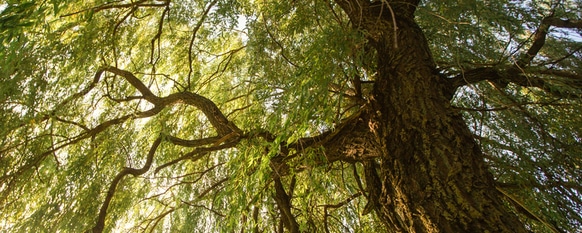Have you ever walked through the branches of a tree? You part them with your hands as they sway in the breeze. Once you clear the cluster of thin, hanging limbs you are enveloped in its canopy and hidden from the world. Kind of a romantic thought and scene.
But the name of this majestic tree is directly derived from an act of sadness. How could something so magical earn its moniker through something so tragic?
There thoughts from every corner of recorded history that attempt to explain this. From Wicca to Christianity. From Louisiana to Czechoslovakia. Wherever you look, its symbolism is associated with something tearfully sad.
Some say that it was the lumber used to build gallows. Others say that its branches were fashioned into a cemetery ornament that represents the sadness of the grieving family. Christian texts contend that the tree weeps in eternal punishment because its branches were used to whip Jesus as he carried the cross to his crucifixion.
There’s no shortage of mystery and myth around this beautiful tragedy of a tree. But what do you really know about it? You’re not alone if it’s just the endearing appearance of its hanging limbs and questions about its name.
That’s the point of this article. Here you’ll find the facts to balance out the fantastic notions that come with weeping willow trees.

General Information
The weeping willow, salix babylonica, is a deciduous tree of Chinese origin. Its open crown of graceful ground-sweeping branches is instantly recognizable. Although it traces its roots (no pun intended) to Asia, it has now naturalized in North America. It is found in more humid climates from Ontario to Georgia and as far west as Missouri.
Weeping willows are fast growing and can gain as much as 48 inches in a year. Despite their aggressive and massive growth habits, they have a short life span of between 30 and 50 years.
They can grow to be 80 feet tall, but most average out somewhere between 40 and 50 feet tall. Remarkably, the spread (width) of its canopy can be the same length as its height.
Their leaves grow to be as long as a dollar bill, but usually wind up being longer than a playing card. The flat, thin leaves are light green with silvery undersides and appear early in the year. They turn into a beautiful yellow in the fall.
When the leaves finally fall from their branches, the exposed silhouette of the individual limbs against a winter sky is stunning. That silhouette remains until late winter or early spring when it produces yellow catkins (flowers). After the beauty of the catkins comes the ugly brown fruit that are seed capsules that will eventually split open to reveal tiny green seeds.
The gray bark is rough to the touch and deeply furrowed and ridged around the base. The trunk connects to a shallow but hearty root system that you must consider when planting them.
Whether or not you believe in the magical or superstitious tales about them, there’s no denying that it is a stately specimen that can give your lawn a look of refinement.
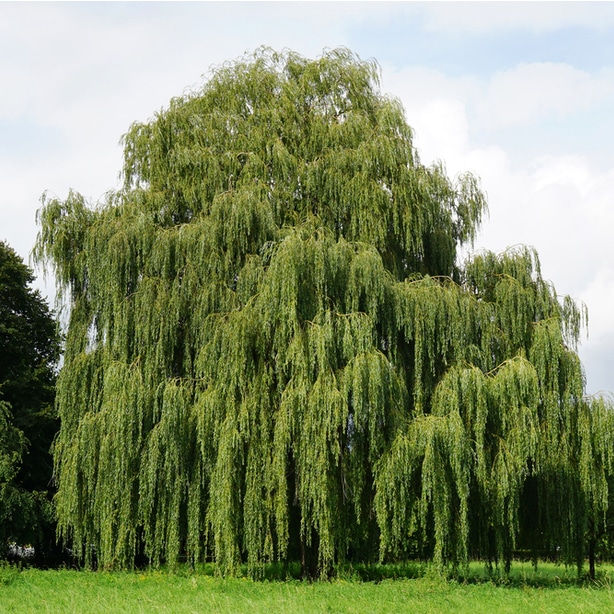
Care Guide
Let’s outline the conditions that these trees need to thrive and flourish around your home.
Soil Conditions
Weeping willows have an affinity for water. That’s the reason you find them so close to ponds, lakes, and streams. In these conditions, the roots of the tree will thicken and grow great distances outward. This makes them helpful in areas that have standing water and in preventing soil erosion.
It can survive a short period of drought, but it’s not suited to environments that have extended dry periods. It can grow in moist and well-drained soils that range from sandy to loamy to clay. The weeping willow isn’t picky when it comes to the soil. So long as there’s an adequate amount of moisture, it’s going to thrive.
Sunlight
Weeping willows grow best in conditions of full sun and partial shade. To break that down, the tree needs at least 4 hours of direct, unfiltered sunlight each day.
They can weather the heat of the summer months with ease so long as it has enough water.
Watering
If your weeping willow is not near a body of water, you must water the soil regularly to meet its moisture requirements. For optimal growth, keep the soil moist but not soggy.
Newly planted trees require 10 gallons of water for every inch of trunk diameter 2 to 3 times a week. Once established, you can lower the frequency to once a week.
The easiest way to ensure you’re delivering 10 gallons per inch is to time how long you take to fill up a 5-gallon bucket twice. Multiply the seconds you clocked by the trunk’s diameter in inches. That number represents the total number of seconds you will need to water.
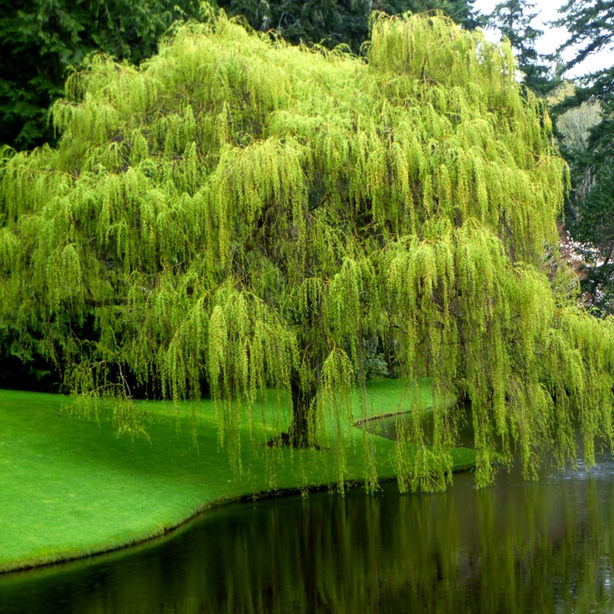
Fertilizing
Although they can grow in a wide variety of soil conditions, they prefer slightly acidic soil. Before you fertilize the tree, perform a soil test to determine the pH level.
Amending the Soil
If you find that your soil’s pH is neutral or alkaline, add sulfur to bring the pH level down to the ideal range between 5.0 and 6.0.
If you have a sapling growing and you need to lower the pH of soil that it is growing in, apply organic matter (cow manure) instead of sulfur, as it can burn up the immature root system. This won’t create the ideal slightly acidic environment, but it will neutralize alkaline soil. Neutralization creates a better environment for the saplings without damaging the roots.
Regular Fertilization
Once you have slightly acidic or neutralized soil, it’s time to choose the fertilizer that’s best suited for the weeping willow. That fertilizer is a well-balanced product with equal ratios of nitrogen, phosphorus, and potassium. A fertilizer with an NPK ratio of 20-20-20 will work perfectly.
The nitrogen supports the healthy growth and color of the leaves throughout their long, sweeping branches. The phosphorus provides for virile growth of the root system, flowers, and stems. And the potassium is for the overall health of the entire tree.
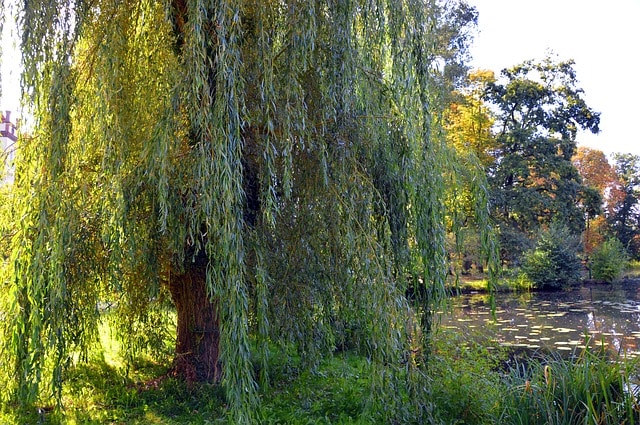
Growing Tips
Here are some things you must keep in mind when planting and caring for weeping willow trees around your home.
Location
Because of its rapid and massive growth, a weeping willow is not well-suited for smaller lawns. It needs space to grow.
The roots of these trees aggressively seek water and grow outward to great distances. This can cause damage to anything that is beneath the surface. Experience has shown me you need to give yourself 60 feet of space between the planting site and anything you don’t want its roots to damage.
So before you plant the tree, contact the appropriate companies to determine where the water pipes and gas lines are located. And it’s not just pipes and lines you have to worry about. Consider these:
- Your home
- Sidewalks
- Driveways
- Septic tank
- Buried pets (you may laugh, but I’m serious)
If you live in an area that has high winds, you may have to construct a wind-block to limit damage to the somewhat brittle branches.

Fertilizer Application
Your weeping willows won’t need a massive dose of fertilizer. Be conservative in the amount you use and how often you use it. These are virile trees that don’t need a lot of help.
When you apply the fertilizer, don’t focus on the tree’s foliage. Instead, apply the fertilizer over the area of ground that contains the extensive root system.
To know how much ground you need to cover, estimate the height of the tree from the trunk to the beginning of the canopy and multiply that number by three. That will give you the approximate breadth of the root system.
Pests and Problems
Pests
The problem with trees that grow as fast as weeping willow is that the wood is brittle and prone to an invasion by pests and disease.
Not only do you have to worry about aphids, gypsy moths, and borers, you also have to contend with opportunistic deer, rabbits, and other herbivorous creatures.
Handle these problems by spraying an insecticide specific to the bug you are battling. As for wildlife, there’s not a lot you can do for mature trees, but you can put a collar around the more vulnerable younger weeping willows.
Diseases
Weeping willows are susceptible to an array of diseases that can cause problems up to and including the death of the tree. Pay attention to the immature trees that you have. Diseases that you may have to contend with are:
- Root Rot
- Black Canker
- Willow Scab
- Willow Blight
- Powdery Mildew
The best way to combat tree disease is prevention. Ensure that you are doing all the caretaking duties properly and regularly.
The debris falling should be picked up promptly. Debris collecting over time underneath the tree is a gateway to infection.
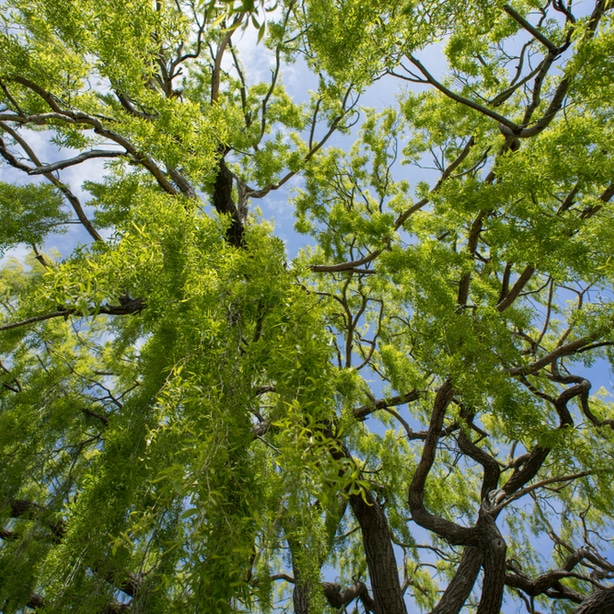
Planting a Weeping Willow
The best time to plant these trees is in the fall so the roots can develop before the first frost. That way, when spring rolls around, the tree is already established and is ready to grow.
Choosing the Site
Take what you’ve learned today and apply it to choose the site.
- Perform a soil test and amend as necessary
- Ensure the soil has good drainage and allows for the free flow of water, air, and nutrients
- Check to see that the area receives sufficient direct, unfiltered sunlight through the day
- Choose an area large enough to account for the rapid and aggressive growth rate of the tree above and below the surface. 60 feet in all directions.
- If next to a water source, allow enough room for the roots to fully extend before reaching the water
Now that you have the site selected, you have the choice of how you plant the tree. You can choose a young tree with a wrapped root ball or propagation. Follow the steps outlined for each method.
Transplanting Process
- Dig a hole twice as wide as the root ball and only slightly deeper
- Set the root ball into the hole and ensure that the trunk is standing up straight
- Fill the hole halfway up with soil
- Pour 2 gallons of water into the hole
- Fill the remainder of the hole with soil
Propagation
Propagation is the practice of cutting the stems of weeping willows and placing them directly into the soil. Ensure the stem cuttings are at least 2 feet long and taken from the base from mature trees that have gone dormant. Place the cuttings directly into the soil in late winter or early spring. Throughout the growing season, the soil should stay moist to encourage the healthy growth of new roots.
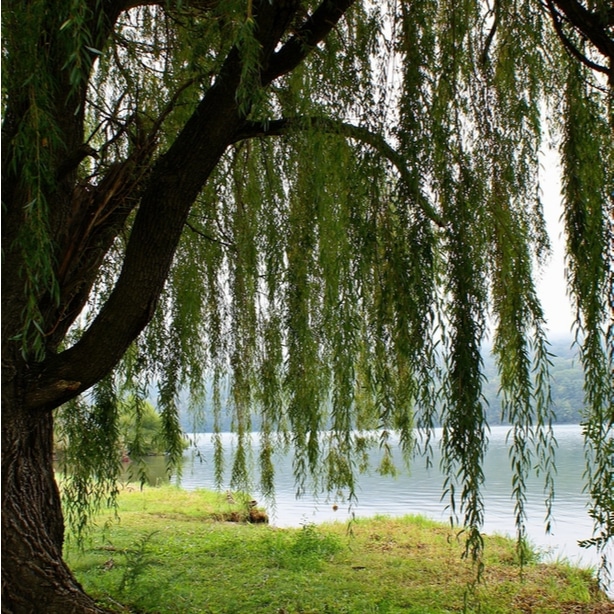
Pruning
Pruning should be done every year in January or February. Look for branches with weaker junctions at the tree’s base. These will be a “V” shape and more likely to break. As your tree matures, it becomes less susceptible to disease.
You also must prune the tree after a storm. Trim back all the broken branches at the point where the damage occurred. If you notice any dead spots, trim them back until you reach the living branch.

